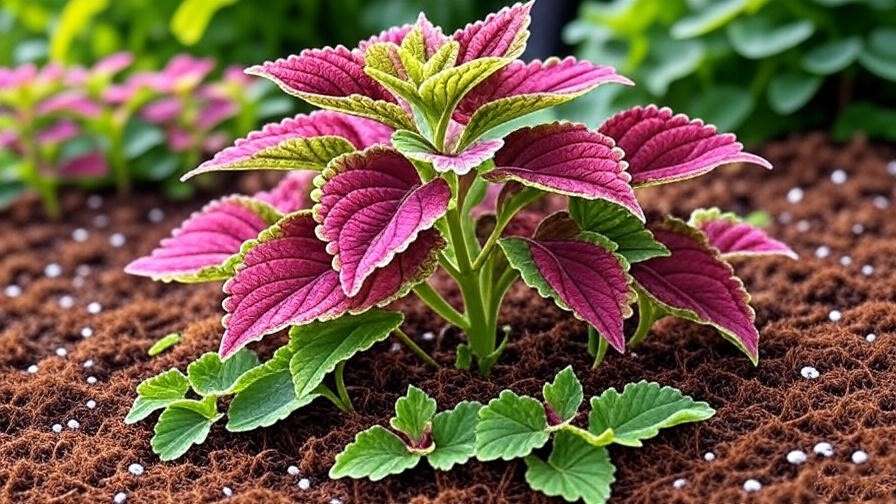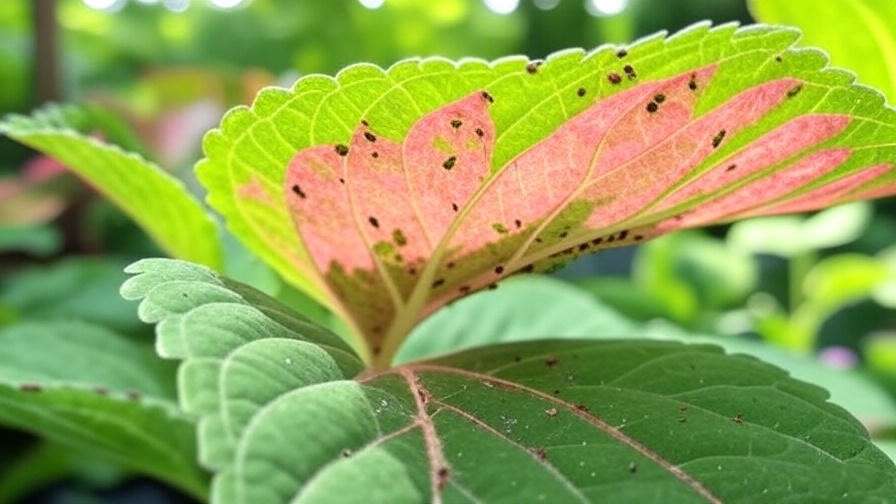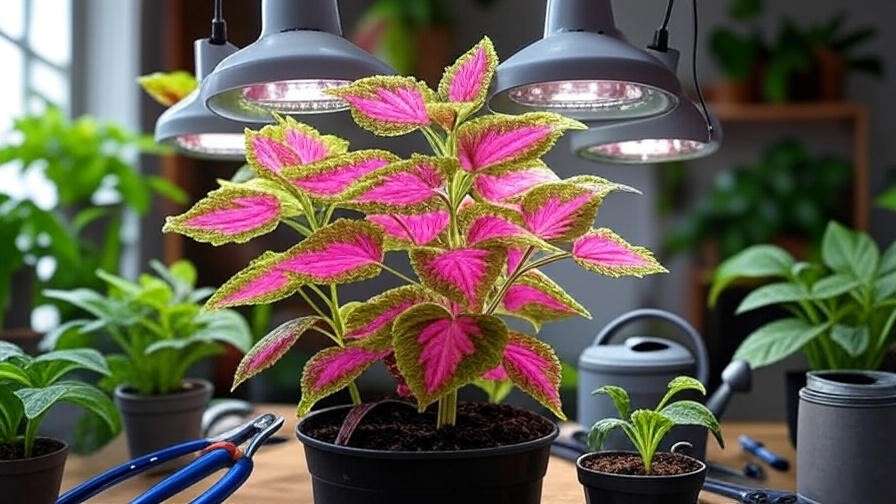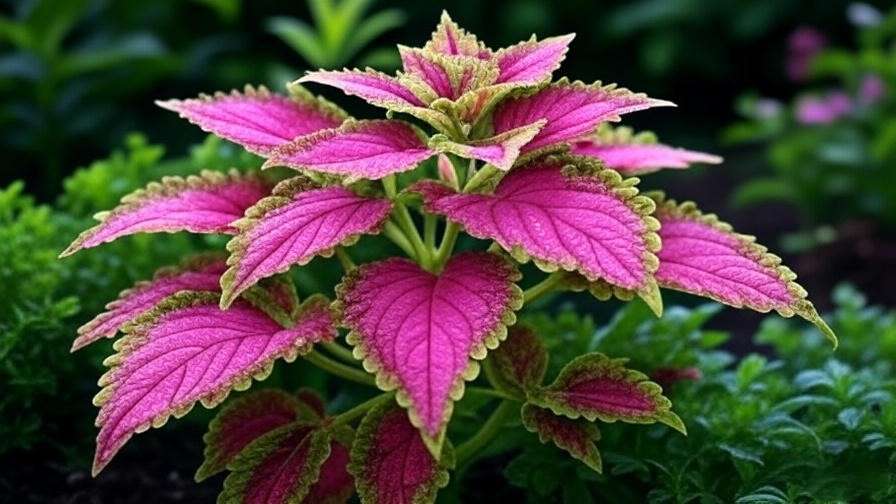Picture this: a burst of pink, green, and yellow foliage that transforms your garden or living room into a tropical paradise. That’s the magic of Coleus Watermelon, a plant that’s stealing the hearts of gardeners everywhere. Whether you’re a beginner or a seasoned plant enthusiast, learning how to grow and care for Coleus Watermelon is your ticket to vibrant, low-maintenance beauty. This stunning plant, known for its watermelon-like hues, is perfect for adding color to patios, borders, or indoor spaces. In this comprehensive guide, we’ll walk you through everything you need to know to cultivate healthy, eye-catching Coleus Watermelon plants. From ideal growing conditions to troubleshooting tips, we’ve got you covered with expert advice to ensure your plants thrive. 🌈
1. What is Coleus Watermelon? 🌈
1.1 Overview of Coleus Watermelon
Coleus Watermelon, scientifically known as Solenostemon scutellarioides ‘Watermelon,’ is a striking variety of coleus prized for its vibrant foliage. Its leaves feature a bold pink center framed by green edges with hints of yellow, resembling the juicy hues of a ripe watermelon. Unlike flowering plants, Coleus Watermelon’s charm lies in its leaves, making it a standout choice for year-round visual interest. Native to tropical regions, this plant adapts well to both indoor and outdoor environments, thriving in warm climates or as a houseplant in cooler regions.
1.2 Benefits of Growing Coleus Watermelon
Why choose Coleus Watermelon? For starters, its vivid colors elevate any space, from garden beds to decorative pots. It’s a low-maintenance plant, perfect for busy gardeners or those new to plant care. Its versatility allows it to shine in mixed containers, hanging baskets, or as a bold border plant. Plus, Coleus Watermelon is a fantastic choice for adding tropical vibes without the high upkeep of more demanding plants. Whether you’re aiming for a lush outdoor display or a pop of color indoors, this plant delivers. 🌱
2. Ideal Growing Conditions for Coleus Watermelon ☀️
To keep your Coleus Watermelon thriving, you need to nail its growing conditions. Here’s how to set it up for success.
2.1 Light Requirements
Coleus Watermelon loves bright, indirect sunlight but can also tolerate partial shade. Aim for 4–6 hours of filtered light daily. Indoors, place it near an east- or west-facing window. Outdoors, choose a spot with morning sun and afternoon shade to prevent leaf scorch. Too much direct sunlight can fade its vibrant colors, while too little light may cause leggy growth. Pro tip: If you notice dull foliage, adjust the light exposure gradually to find the sweet spot. 💡
2.2 Soil Preferences
This plant thrives in well-draining, rich soil with a slightly acidic pH (6.0–6.5). A mix of potting soil, peat moss, and perlite works wonders. For a DIY soil blend, combine:
- 50% high-quality potting soil
- 30% peat moss or coconut coir
- 20% perlite or vermiculite for drainage Good drainage is critical to prevent root rot, a common issue with overwatered coleus. If planting in containers, ensure pots have drainage holes. 🌍

2.3 Temperature and Humidity
Coleus Watermelon prefers temperatures between 60–85°F (15–29°C). It’s sensitive to frost, so bring outdoor plants indoors if temperatures drop below 50°F (10°C). High humidity (50–60%) enhances its foliage vibrancy, making it ideal for bathrooms or kitchens when grown indoors. In dry climates, mist the leaves or use a pebble tray to boost humidity. Avoid placing near drafty windows or heating vents, which can stress the plant. ❄️
3. Planting Coleus Watermelon: Step-by-Step Guide 🌱
Whether starting from seeds or cuttings, planting Coleus Watermelon is straightforward with the right approach.
3.1 Starting from Seeds
Sowing seeds is a cost-effective way to grow Coleus Watermelon. Start in early spring for outdoor planting or anytime for indoor growth. Here’s how:
- Fill a seed tray with a seed-starting mix.
- Sprinkle seeds lightly on the surface; don’t cover, as they need light to germinate.
- Mist the soil to keep it moist and place the tray in a warm spot (70–75°F).
- Expect germination in 10–14 days.
- Transplant seedlings to individual pots once they have 2–3 true leaves. Timeline: Seedlings are ready to move outdoors after 6–8 weeks, post-last frost. 🌱
3.2 Propagating from Cuttings
Propagation is a gardener’s favorite for multiplying Coleus Watermelon. Follow these steps:
- Cut a 4–6-inch stem just below a node using clean scissors.
- Remove lower leaves, leaving 2–3 at the top.
- Place the cutting in water or moist soil; roots form in 1–2 weeks.
- Optional: Dip the cut end in rooting hormone to speed up rooting.
- Transplant rooted cuttings to pots or garden beds. Expert tip: Water propagation lets you monitor root growth, making it ideal for beginners. 🌿

3.3 Transplanting Tips
When transplanting, space plants 12–18 inches apart in garden beds to allow for bushy growth. For containers, choose pots at least 8–10 inches wide. Gradually acclimate plants to outdoor conditions over 7–10 days to reduce shock. Water thoroughly after transplanting and monitor for signs of stress, like wilting, which may indicate too much sun or insufficient water. 🌳
4. Caring for Coleus Watermelon: Essential Tips 🪴
Proper care ensures your Coleus Watermelon stays lush and vibrant. Here’s what you need to know.
4.1 Watering Needs
Keep the soil consistently moist but not waterlogged. Water when the top inch of soil feels dry, typically every 2–3 days for outdoor plants or weekly for indoor ones, depending on conditions. Overwatering leads to yellowing leaves or root rot, while underwatering causes drooping or crispy edges. Use room-temperature water to avoid shocking the plant. For outdoor plants, morning watering reduces evaporation and fungal risks. 💧
4.2 Fertilizing for Vibrant Growth
Feed Coleus Watermelon every 2–4 weeks during the growing season (spring to early fall) with a balanced, water-soluble fertilizer (10-10-10 or 20-20-20). Dilute to half-strength to avoid overfeeding, which can cause leggy growth or faded colors. Organic options like fish emulsion or compost tea work well for eco-conscious gardeners. Stop fertilizing in winter when growth slows. Pro tip: Always water before fertilizing to protect roots. 🌼
4.3 Pruning and Pinching
Pinching back stems encourages bushier growth and prevents legginess. Use clean scissors to snip just above a leaf node every 2–3 weeks. Remove flower buds to focus energy on foliage, as blooms are less showy. Regular pruning also shapes the plant for a fuller appearance. Expert insight: Pinch young plants early to promote branching from the base. ✂️

5. Common Problems and Solutions 🐞
Even with the best care, Coleus Watermelon can face challenges. Here’s how to tackle common issues to keep your plants thriving.
5.1 Pests to Watch For
Coleus Watermelon can attract pests like aphids, spider mites, and whiteflies, especially in warm, dry conditions.
- Aphids: These tiny sap-suckers cluster on new growth, causing leaves to curl. Spray with a strong jet of water or apply insecticidal soap.
- Spider Mites: Look for fine webbing and stippled leaves. Increase humidity and use neem oil for control.
- Whiteflies: These small, white insects fly up when disturbed. Use yellow sticky traps or a mild soapy water solution.
Preventative measures: Regularly inspect undersides of leaves and plant companion plants like marigolds to deter pests. Expert tip: Avoid overcrowding plants to improve air circulation and reduce pest risks. 🕷️

5.2 Diseases and How to Prevent Them
Fungal diseases like powdery mildew and root rot are the primary threats to Coleus Watermelon.
- Powdery Mildew: Appears as white, powdery spots on leaves. Ensure good air circulation and avoid overhead watering. Treat with a fungicide if severe.
- Root Rot: Caused by overwatering or poor drainage, leading to wilting or yellowing. Use well-draining soil and pots with drainage holes.
Prevention: Water only when needed and ensure proper spacing between plants. Expert insight: Sterilize tools and pots to prevent fungal spread. 🦠
5.3 Troubleshooting Fading or Dull Foliage
If your Coleus Watermelon’s vibrant colors fade, the culprit is often light, nutrients, or stress.
- Light Issues: Too much direct sun can bleach leaves, while too little causes dullness. Adjust to bright, indirect light.
- Nutrient Deficiencies: Lack of nitrogen or potassium can mute colors. Apply a balanced fertilizer as outlined in section 4.2.
- Stress: Overwatering, underwatering, or sudden temperature changes can affect foliage. Maintain consistent care routines.
Case study: A gardener noticed their indoor Coleus Watermelon losing its pink hue. By moving it to a brighter window and fertilizing biweekly, the plant regained its vibrancy within a month. 🌈
6. Creative Uses for Coleus Watermelon in Your Space 🎨
Coleus Watermelon’s bold foliage makes it a versatile addition to any garden or home. Here are creative ways to showcase it.
6.1 Landscaping Ideas
In outdoor settings, Coleus Watermelon shines in mixed borders or as a focal point in garden beds. Pair it with plants like ferns, hostas, or impatiens for contrasting textures and colors. Its vibrant hues complement purple or silver foliage, creating a dynamic display. Use it in mass plantings for a bold statement or as an accent in rock gardens. Design tip: Plant in groups of three or five for visual impact, spacing them 12–18 inches apart. 🌳
6.2 Indoor Decor
As a houseplant, Coleus Watermelon adds tropical flair to any room. Place it in decorative ceramic pots or hanging baskets near windows with filtered light. It’s perfect for brightening up bathrooms, kitchens, or living rooms. For a modern look, combine with sleek, minimalist planters. Styling example: Create a tropical-themed corner by grouping Coleus Watermelon with pothos and peace lilies in coordinating pots. 🪴
6.3 Seasonal Displays
Coleus Watermelon’s colors make it ideal for seasonal arrangements. In summer, use it in patio containers with petunias or calibrachoa for a vibrant display. In fall, pair it with ornamental grasses or mums for a warm, autumnal look. In colder climates, bring potted plants indoors before the first frost to enjoy year-round. Pro tip: Transition outdoor plants to indoor settings gradually to avoid shock. 🍂

7. Expert Insights: Maximizing Coleus Watermelon’s Potential 🌟
To elevate your Coleus Watermelon game, we consulted horticulturist Dr. Emily Carter, who has over 15 years of experience in ornamental plant cultivation. “Coleus Watermelon is a dream for gardeners because it’s forgiving yet responsive to fine-tuned care,” she says. “Experiment with light exposure to intensify the pink and yellow tones—slight variations can make a big difference.”
Advanced tip: Try growing Coleus Watermelon under grow lights with adjustable spectrums to enhance specific colors. For example, more red light can boost pink hues. Myth-busting: Contrary to popular belief, Coleus Watermelon doesn’t need constant direct sunlight to thrive—bright, indirect light is often better for long-term health. 🌞

8. FAQs About Coleus Watermelon ❓
Here are answers to common questions, backed by research and expert knowledge:
- Can Coleus Watermelon survive winter outdoors? No, it’s frost-sensitive. In zones below 10, bring it indoors or treat it as an annual.
- How do I make my Coleus Watermelon bushier? Pinch back stems regularly, starting when the plant is young, to encourage branching.
- Is Coleus Watermelon safe for pets? It’s generally non-toxic but may cause mild stomach upset if ingested. Keep out of reach of curious pets.
- Why are my plant’s leaves dropping? Common causes include overwatering, low humidity, or cold drafts. Check care conditions and adjust accordingly.
- How often should I repot my Coleus Watermelon? Repot every 1–2 years or when roots outgrow the pot, using fresh, well-draining soil.
9. Conclusion: Grow Vibrant Coleus Watermelon with Confidence 🌿
Coleus Watermelon is a gardener’s delight, offering vibrant foliage, easy care, and endless styling possibilities. By providing the right light, soil, and care, you can enjoy its stunning pink, green, and yellow leaves year-round. Whether you’re propagating cuttings, designing a tropical garden, or brightening your home, this plant delivers unmatched beauty with minimal effort. Start growing your Coleus Watermelon today and share your success with us using #ColeusWatermelonVibes on social media! Ready to explore more colorful plants? Check out our guides on “Top 10 Colorful Foliage Plants” or “How to Propagate Houseplants” for more inspiration. 🌱


















